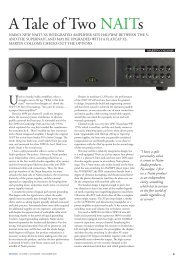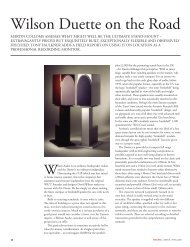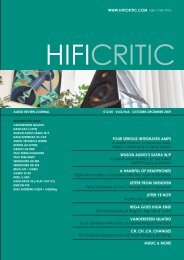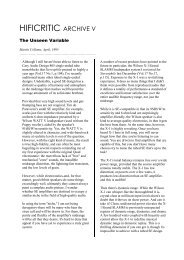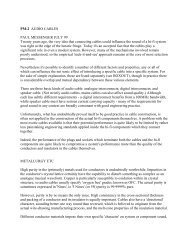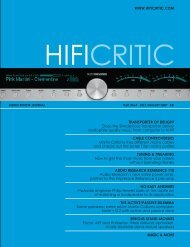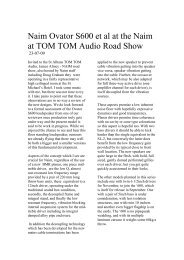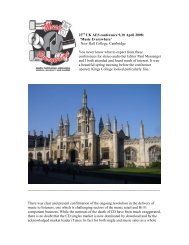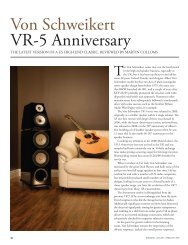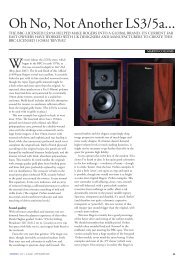IB2i - Hificritic.com
IB2i - Hificritic.com
IB2i - Hificritic.com
Create successful ePaper yourself
Turn your PDF publications into a flip-book with our unique Google optimized e-Paper software.
WWW.HIFICRITIC.COM ISSN 1759-7919<br />
HIFICRITIC<br />
AUDIO REVIEW JOURNAL £12.50 Vol3/No3 JULY-SEPTEMBER 2009<br />
REVIEWED THIS ISSUE:<br />
LINN LP12 RADIKAL<br />
LINN KEEL FOR ARO<br />
PMC <strong>IB2i</strong><br />
DCS PAGANINI TRANSPORT<br />
DCS PAGANINI DAC<br />
DCS PUCCINI U-CLOCK<br />
AESTHETIX CALYPSO<br />
BRYSTON BP26<br />
ROKSAN PLATINUM PRE-AMP<br />
CHORD QBD76<br />
REHDEKO RK175<br />
ROGERS LS3/5A (NEW)<br />
CRYSTAL BRIDGE<br />
XTZ ROOM ANALYSER<br />
SUPERCHARGING THE SONDEK<br />
Linn’s LP12 SE enhancements<br />
VINYL (THERE ARE NO) RULES!<br />
Are audiophile LP re-releases any good?<br />
A MINEFIELD IN MINIATURE<br />
The bi-wiring conundrum<br />
UP THE DCS STAIRCASE<br />
Getting to grips with the state of the digital art<br />
A STUDIO MONITOR FOR THE HOME?<br />
PMC’s <strong>IB2i</strong> gets the full treatment<br />
DELICIOUS DAC<br />
Chord Electronics’ gorgeous QBD76<br />
SMOKE & MIRRORS<br />
The recording techniques that won Jim Anderson<br />
nine Grammys<br />
THREE SERIOUS PRE-AMPS<br />
Classy pre-amps from Aesthetix, Bryston and Roksan<br />
MUSIC & MORE<br />
HIFICRITIC JULY | AUGUST | SEPTEMBER 2009 29
A Studio Monitor<br />
For the Home?<br />
THE EDITOR DECIDES THAT ONE OF HIS PERSONAL FAVOURITES<br />
SHOULD GET THE FULL CRITICAL COLLOMS TREATMENT<br />
This <strong>IB2i</strong> speaker is built by PMC – the<br />
UK’s Professional Monitor Company,<br />
which self evidently makes studio monitors<br />
alongside many other speaker designs of different<br />
shapes, sizes and purposes, all of which feature<br />
the <strong>com</strong>pany’s ATL (advanced transmission line)<br />
bass loading. Is there a difference between a studio<br />
monitor and a domestic hi-fi loudspeaker? In<br />
theory, no: both should be accurate, informative,<br />
have low coloration, provide focused stereo images<br />
and recover lots of detail.<br />
Our review model was the attractively finished,<br />
real walnut veneered <strong>IB2i</strong>, a broad equivalent to<br />
the Pro-Audio IB2S version. Although the two<br />
have much in <strong>com</strong>mon, they’re not identical. The<br />
IB2S has an alternative tweeter, is finished in a<br />
durable matt textured ‘Neo Black’ and incorporates<br />
three alternative treble control settings (for film<br />
soundtrack balancing). It also has an active drive<br />
option, which is only available with PMC’s larger<br />
domestic models.<br />
Our review <strong>IB2i</strong> is a large no bullshit standmount,<br />
with the broad performance profile of a<br />
classic Spendor BC3 or SA100 three-way monitor.<br />
But it’s actually rather more <strong>com</strong>pact than those<br />
examples, and more obviously <strong>com</strong>parable to ATC’s<br />
slightly smaller port-loaded SCM50SL, a threeway<br />
monitor that’s available in several domestic<br />
and Pro versions (active or passive, stand-mount or<br />
floorstanding), and is its most obvious <strong>com</strong>mercial<br />
<strong>com</strong>petition.<br />
PMC also makes a floorstanding equivalent of the<br />
<strong>IB2i</strong> called the EB1i. Its slightly longer transmission<br />
line promises marginally deeper bass, but the lower<br />
price reflects the fact that it’s fitted with a less costly,<br />
bought-in midrange driver. But it does still beg the<br />
question: “why should you want the stand-mount<br />
version?”. (Paul Messenger also alluded to this in his<br />
<strong>com</strong>parative review in vol. 3 no1.)<br />
Like PM, I recognise that stand mount designs<br />
deliver a certain degree of free articulation in the<br />
lower midrange and bass. This I suspect is down<br />
to the fact that the staggered spacing to the three<br />
nearest room boundaries may produce a smoother<br />
in-room response than the essentially two available<br />
with a floorstander, though I appreciate that that is<br />
something of a simplification in the <strong>com</strong>plex real<br />
world of coupled acoustics. Whatever, the <strong>IB2i</strong><br />
<strong>com</strong>bines the advantages of a tolerably sized stand<br />
mount with the high power handling capabilities of a<br />
medium studio monitor.<br />
A 2.4m transmission line is folded within its<br />
modest dimensions, and this is terminated by a<br />
large rectangular front port – clearly way too big to<br />
function as an ordinary bass reflex port. Technically,<br />
the line presents a <strong>com</strong>plex acoustic back load to<br />
the bass driver, and the designer has considerable<br />
freedom to fine tune the quantity and placing of<br />
damping and absorption <strong>com</strong>ponents, such as<br />
foam blocks and wadding. These help control the<br />
relative level of upper and lower bass contribution<br />
from the line, and are designed to suppress the<br />
natural harmonic resonances of what is, acoustically<br />
speaking, a multi-resonance tuned pipe.<br />
Since the sound from the back of a piston driver is<br />
naturally out of phase with that from the front, and<br />
can potentially cancel main signal, the other purpose<br />
of an extended line is to delay and thus phase shift<br />
the lowest frequencies so they are sufficiently phase<br />
reversed to make a positive contribution to the<br />
overall output when they emerge from that large<br />
aperture, rather than cancel negatively. In fact the<br />
loading is closer to a quarter-wave inverter than a<br />
reflex, so a tighter transient response can be expected.<br />
Furthermore, those secondary resonances often need<br />
careful adjustment so as not to add coloration to the<br />
low frequency band.<br />
Clearly there are questions about delay arising<br />
from the transit time down the line and whether<br />
the resulting bass will have significant, audible<br />
group delay. There is more to the perception of<br />
good bass timing than group delay alone and the<br />
designer has a big say in how any speaker sounds,<br />
having the opportunity to fine tune and balance<br />
a number of design parameters. The proof will be<br />
found in the listening.<br />
I remember that classic transmission lines often<br />
went deep but sounded slow. This one, even from<br />
early auditioning, sounds deep and fast. And I know<br />
how dynamic it can also be, since I heard it driving<br />
an audience of 90 persons in a large and reflective<br />
lecture hall for the London AES, with nary a squeak<br />
of bass limiting or audible distortion. And it was<br />
LOUD. In fact under domestic conditions I reckon<br />
30 HIFICRITIC JULY | AUGUST | SEPTEMBER 2009
◆ REVIEW<br />
MARTIN COLLOMS<br />
more distortion will be generated in the ears than<br />
from this loudspeaker.<br />
The styling is classic box speaker, nicely finished<br />
in walnut. Some visitors said it looked oldfashioned,<br />
which didn’t bother me, but it’s clear that many<br />
consider narrower, faceted or curvaceous speakers<br />
more elegant. The three terminal pairs are not<br />
special, and their brass linking rods were poor,<br />
in particular impeding the use of spade cable<br />
terminations. I replaced these links with properly<br />
done up solid copper wire and enjoyed an immediate<br />
improvement in mid and treble clarity. The grille was<br />
also weak, the frame thin enough to be warped by<br />
the fabric tension and barely holding on to its few<br />
studs. Measurement (1.2dB loss plus +/-2dB ripple<br />
in the upper range) and listening (loss of clarity and<br />
dynamics) showed that the grille introduced real<br />
impairment, so I simply left it off.<br />
Technology<br />
The drivers are centrally mounted in a vertical<br />
line, with little consideration given to enclosure<br />
diffraction, nor any pretensions to time alignment.<br />
Will this detract from performance? Well, it<br />
depends. Time alignment has audible but secondary<br />
benefits, and I consider it should not be the goal<br />
if it <strong>com</strong>promises primary characteristics. In the<br />
<strong>IB2i</strong> those fundamentals are fully addressed; in the<br />
cruel world of the professional, failure to perform is<br />
rewarded by the sound of the studio door slamming<br />
after you.<br />
Bass <strong>com</strong>es from a 10in (250mm) driver with a<br />
planar 190mm diaphragm of carbon fibre skins on<br />
a Nomex honey<strong>com</strong>b core. This is driven by a high<br />
power handling 75mm voice coil, with the desirable<br />
if rare <strong>com</strong>bination of a short coil in a long gap. The<br />
moving parts are stabilised via a double spider and<br />
a stiff half-roll surround. A planar bass unit has the<br />
advantage of smoothly continuing the front panel<br />
profile, whereas conventional cone drivers suffer from<br />
some coupled resonance coloration and diffraction<br />
due to their conical cavity. If the bass unit mounting<br />
looks a bit weak with just four small socket head<br />
bolts, that is only for the metal trim; underneath<br />
it is securely fixed by eight massive bolts. Looking<br />
inside, I felt that although the moderate spring-grip,<br />
push-to-release connections to the bass unit were<br />
handy for easy servicing and avoided soldering, high<br />
retention spades or better still hard soldered joints<br />
might sound better regardless of the inconvenience.<br />
The midrange unit is PMC’s heroic 75mm softdome<br />
driver with a custom doped fabric diaphragm<br />
and very powerful coil and magnet assembly, capable<br />
of very high sound levels at low distortion.<br />
The product of cooperative design work with<br />
SEAS the double back-loaded 27mm ‘Sonolex’<br />
(doped fabric) soft dome tweeter is custom made for<br />
PMC, and has ferrofluid cooling to increase dynamic<br />
headroom.<br />
The high order, nominally Linkwitz-Riley<br />
crossovers have precision 24dB/octave slopes<br />
at 380Hz and 3.8kHz, and driver pass-band<br />
equalisation. A mixture of electrolytic and<br />
polypropylene film capacitors are used alongside<br />
ferrite-cored and air-cored inductors. These are<br />
good quality <strong>com</strong>ponents, but not so-called<br />
‘audiophile’ grade.<br />
HIFICRITIC JULY | AUGUST | SEPTEMBER 2009 31
◆ REVIEW<br />
Sound Quality<br />
A revealing and fundamentally accurate transducer,<br />
the <strong>IB2i</strong> reads sources well. It needs quite a lot of<br />
current, is best suited to amplifiers of 50W upwards,<br />
and showed no sign of flagging when fed 400W. If<br />
you want to hear that stomping, percussive, visceral<br />
low frequency output, you need a stomping amplifier<br />
to drive it.<br />
I cannot speak for the PMC-distributed Brystons,<br />
not having heard them for a while, but the generous<br />
output current of Naim’s 80+80W SuperNait, had a<br />
good go, while it sailed away on my reference 350W<br />
and 40A peak Conrad Johnson Premier 350SA. Here<br />
the peak current drawn by the <strong>IB2i</strong> is estimated at<br />
nearly 30A max.<br />
The sound is bold, muscular, lifelike, not quite<br />
larger than life, but evidently high in contrast and<br />
definition. Forget considerations of sweetness and<br />
micro-focus; instead wonder at the studio grade<br />
dynamics, the confident, even assertive drive that’s<br />
able to deliver the entire musical content in the<br />
programme.<br />
If a speaker reflects a designer’s intention and<br />
taste, then I hear his intention here as delivering the<br />
audio message, and more importantly answering<br />
the following questions: how a track is constructed;<br />
how present are all the frequencies; what is the<br />
programme tonal balance; is there any distortion;<br />
is there unwanted low level noise; are the right<br />
mikes connected; and how are they placed relative<br />
to the instrument or performer? And not least, how<br />
is the overall production balanced from track to<br />
track? Answer these questions well, and you define a<br />
truthful and informative loudspeaker.<br />
Characteristically, familiar tracks replayed on the<br />
<strong>IB2i</strong>s sound rather like you always thought they were<br />
meant to sound; how you imagine you would have<br />
heard them played back in the studio.<br />
The <strong>IB2i</strong> does this by first laying down a beat,<br />
where bass, mid and treble are unmistakably dynamic<br />
and propulsive. A drum kit sounds percussive, lively,<br />
crisp; as it should. It backs the band; as it should.<br />
Vocals <strong>com</strong>e over with excellent clarity; particularly<br />
clear enunciation is unmistakeably of quality<br />
monitor standard. As a track begins you are clear<br />
about the production, how many musicians, and<br />
when they <strong>com</strong>e in, how the track is built, and what<br />
you think the producer intended.<br />
The treble is crisp, detailed, just a tad ‘edgy’ at<br />
times, but well in keeping with the sparkling, livesound<br />
effect. Where an audiophile designer might<br />
be tempted to smooth things over, PMC keeps<br />
the energy going and makes sure that the overall<br />
performance delivers the information the recording<br />
engineer needs. Drum sounds are consistently<br />
faithful: snare, rim, brushwork, all are vividly<br />
reproduced, driving the rhythm forward.<br />
Note that this is not a nearfield monitor,<br />
<strong>com</strong>pensated for proximity and/or for mixing desk<br />
boundary effects. Instead it is designed for free-field<br />
use on stands, and such is its inherent accuracy that<br />
it will fit easily into larger domestic environments<br />
while still maintaining a truthful inherent balance.<br />
The big bass is well matched to studios with some<br />
bass absorption trap tailoring.<br />
While the bass and treble are good, of which more<br />
later, the midrange is undoubtedly the star, showing<br />
subtlety, depth, excellent detail, and low coloration.<br />
Yes there is just a hint of that characteristic ‘doped<br />
soft dome’, almost ‘fibrous’ diaphragm sound, but<br />
it is proportionately less objectionable than the<br />
frequently ‘shouty’ cone drivers often employed in<br />
this position. Indeed, it’s easily forgotten, and this<br />
dome driver’s unfailing purity, openness, uniformity,<br />
and dynamics are achieved with no squeak or<br />
stridency. It joins up beautifully to the treble and<br />
you could buy this speaker for the midrange alone,<br />
and for its magic sound on vocals. It can make many<br />
costly audiophile speakers sound a bit muffled.<br />
The whole bass register, including driver and<br />
line contributions, must be balanced against the<br />
midrange. This has been done well. The bass is quite<br />
tuneful, is punchy, almost percussive in its near live<br />
quality, and is well extended to better than 25 Hz inroom.<br />
The often difficult to tame line contributions<br />
have been excellently blended with the overall<br />
output.<br />
It is unmistakeably lively but the icing on the<br />
cake is its astonishing bass power capacity. This<br />
<strong>com</strong>bination of line and custom driver is clearly well<br />
optimised, and delivers the power and dynamics<br />
worthy of a 12in unit, so the bass end performs<br />
well out of its size and class. The <strong>IB2i</strong> delivers a<br />
muscular, authoritative and fundamentally accurate<br />
sound, making many domestic speakers sound like<br />
overpriced wimps.<br />
Imaging shows good depth, particularly in the<br />
midrange, although it doesn’t achieve the far depth<br />
resolution found in more costly creations. Coloration<br />
is low, but not vanishing so, yet the balance of<br />
coloration, including some moderate contributions<br />
from the enclosure, is somehow blended so that<br />
one doesn’t really care, and discovers that it’s the<br />
whole sound that really convinces. Thus piano is not<br />
the most accurate, but is very clear, live sounding,<br />
dynamic, and highly expressive. So which matters<br />
more, subjective performance or some possibly more<br />
sterile criterion for low coloration?<br />
Just slightly lean in mid timbre, you might expect<br />
it to jump forward on difficult material, eg Jan<br />
32 HIFICRITIC JULY | AUGUST | SEPTEMBER 2009
◆ REVIEW<br />
Gabarek on sax, but the mid is so classy that it sails<br />
through even on this. Conversely, if the source is<br />
rough, forced and <strong>com</strong>pressed, it will be laid bare.<br />
Most listeners will find it fast, informative and<br />
dynamically expressive, particularly on ‘studio’<br />
recordings with healthy reverb, such as Patricia<br />
Barber’s Café Blue, on which it works very well<br />
indeed. Conversely, older more subtle material,<br />
such as Joni Mitchell’s Blue, shows some loss of low<br />
level detail and the temporal coherence which helps<br />
support the sense of timing. Here it does not match<br />
the musical timing of a Naim SL-2 or indeed the<br />
essentially time coherent Avalon Eidolon (though I<br />
accept that the latter is many times more expensive).<br />
A nearer <strong>com</strong>petitor is the rather larger floorstanding<br />
Wilson Audio Sophia 2, which resolves depth and<br />
focuses very well, though it does cost forty per cent<br />
more. A personal audition with familiar music will<br />
help resolve issues such as these.<br />
Lab Report<br />
The type of studio monitor with horn-loaded mid<br />
and treble can have efficiencies as high as or higher<br />
than 96dB/W, and therefore need to be large to<br />
deliver reasonably extended bass. With its direct<br />
radiator mid and treble, the <strong>IB2i</strong> is not more efficient<br />
than most domestic speakers of its type, and has only<br />
average 85.5dB sensitivity for its 5ohms nominal<br />
impedance. While generally 6ohms, the amplifier<br />
load is a reactive (52 degrees) at 5ohms for 70Hz.<br />
Furthermore, over the bass ‘power’ range 80-120Hz<br />
the actual impedance is a low 3.6ohms. It also falls<br />
to 5ohms in the upper treble. The effective port<br />
resonance is confirmed at a low 30Hz. This is a<br />
6ohm speaker, and if a valve amplifier is to be used<br />
it should quite powerful with a good current delivery.<br />
Examining the set of frequency responses, the bass<br />
response is well extended to about 23 Hz -6dB and<br />
is very healthy from 27Hz up, essentially free field,<br />
if elevated about 3dB on the main range, and thus<br />
suited to larger rooms with modest low frequency<br />
gain. It is very smooth across the broad midband,<br />
120Hz-8kHz, en<strong>com</strong>passing both crossover points,<br />
with closely toleranced +/-2.5dB amplitude limits.<br />
Taking note of the natural narrowing directivity<br />
of the dome tweeter in the final octave, this latter<br />
frequency band is designed to rise by about 2.5dB,<br />
even at the optimal measured angle (10 degrees<br />
lateral, on the midrange axis), and I had found that<br />
the upper treble was subjectively presented a little<br />
forward of the main image. Conversely the ‘room<br />
sound’ was nicely open, whereas some other large,<br />
flat front speakers can often sound dulled in the<br />
upper frequency range.<br />
At 15 degrees below axis it is great (black<br />
trace, dip is due to floor reflection), but its above<br />
axis response is notched by 15dB at 3.8kHz, so a<br />
listening position near or a little below the designed<br />
midrange axis is best, with the speakers slightly<br />
toed out from the pure triangle formation. The<br />
lateral off-axis responses are very good, smooth and<br />
even, showing that good attention has been paid to<br />
integration (right out to 60 degrees off-axis) and to<br />
the fine power response which you hear voicing the<br />
room acoustic.<br />
Confirmation of the above, and of the rich<br />
extended bass is given in the room averaged response.<br />
Here up to 5dB of lower bass lift is present even<br />
in my semi open-plan layout, but like PM I did<br />
acclimatise to it to some degree. The rest of the curve<br />
shows the fine balance and integration achieved for a<br />
monitor based design.<br />
I would rate this speaker at 400W music<br />
programme power handling, which will provide very<br />
decent in-room sound levels of 106dB and a bass<br />
dynamic range that’s also sufficient for larger rooms.<br />
I found it possible to apply really high sine wave<br />
levels – 26V (85W) at 25Hz , 29V (105W) at 30Hz<br />
and 35V (150W) at 40Hz – before overload, so the<br />
bass driver and loading method is very capable.<br />
Distortion was generally low, particularly in the<br />
mid and treble, but that’s not to say the bass was<br />
not good too. For 30 Hz, 96dB spl, second and<br />
third harmonics were about 3%, below audibility.<br />
At 120 Hz, 86dB, second was 0.1%, third still fine<br />
at 0.15%. At a higher 96dB spl some rise was to be<br />
expected, now second recorded 0.6%, but third still a<br />
fine 0.15% (credit that fine motor). (For the record,<br />
fourth and fifth harmonics were better than 0.06%.)<br />
By 200Hz some increase was noted, but nothing to<br />
cause concern, for example at 96dB second harmonic<br />
was at 1%, third a very good 0.13%.<br />
Moving on to that midrange unit, for 700Hz<br />
and 86 dB spl I measured 0.033% second and<br />
0.003% third, both superb results, and distortion<br />
was still better than 0.1% total at 96dB spl, which<br />
is pretty loud for sine wave drive. The tweeter also<br />
was excellent, with distortion almost as low as that<br />
remarkable midrange driver.<br />
I used relative nearfield measurement to check<br />
the crossovers and found the acoustic responses to be<br />
well behaved at 380 Hz, approx 24dB/octave, and at<br />
3.6kHz actually nearer 29dB/octave. The tweeter’s<br />
good power handling is aided by the fact that its<br />
frequency response is tailored to a massive 45dB<br />
down by1kHz.<br />
Stethoscope and accelerometer analysis confirmed<br />
significant panel resonances in the midband, for<br />
example at 260Hz, for the back and sides which<br />
represent a significant radiating area. While multiple<br />
HIFICRITIC JULY | AUGUST | SEPTEMBER 2009 33
HIFICRITIC<br />
Awards<br />
BEST BUY 2009<br />
PMC <strong>IB2i</strong>, FB1i<br />
RECOMMENDED 2009<br />
PMC Fact-8, OB1i<br />
Review System<br />
Naim SuperNait, Conrad<br />
Johnson 350SA, XTC 100<br />
power amplifiers, XTC PRE-2,<br />
Conrad Johnson ACT2-2, and<br />
Audio Synthesis Passion preamplifiers,<br />
Naim SuperLine<br />
phono stage, Linn LP12/<br />
Origin Live DC motor/Naim<br />
ARO/Koetsu Urushi Sky Blue,<br />
Naim CDS3, Marantz CD-7<br />
players. Cables by vdH and<br />
Transparent.<br />
Comparison Speakers: Avalon<br />
Eidolon Diamond, Quad<br />
ESL63, 15ohm LS3/5a, Sonus<br />
Faber Guarneri Homage,<br />
Meridian DSP7200.<br />
Contact:<br />
Tel: 01582 405694<br />
www.pmc-speakers.<strong>com</strong><br />
bracing is present from the folded line partitions, the<br />
enclosure remains quite lively by modern standards.<br />
There is some enclosure coloration but it’s handled in<br />
such a way as not to be obtrusive .<br />
This behaviour cannot be seen on the waterfall<br />
energy decay display, since this primarily assesses<br />
the axial sound output over a necessarily short,<br />
resolution limiting time window. Here the essentially<br />
uniform response can be seen in the top line of the<br />
‘waterfall’, with good initial clearing, though with<br />
some time differential then evident between mid and<br />
treble, then some clutter shows, earlier than usual.<br />
Anechoic measurement would be required to decode<br />
this data properly. The decay responses themselves<br />
are not particularly smooth and minor decay ‘ridges’<br />
are also evident at about 18kHz and 11kHz.<br />
Conclusions<br />
I found the sound quality was highly consistent<br />
over all classes of material. This speaker is even<br />
tempered, always upbeat, well <strong>com</strong>mitted to musical<br />
performances, and with very clean articulate vocals.<br />
The upper end of the frequency range is slightly<br />
lifted, which projects the treble somewhat. It has a<br />
first rate, dynamic and detailed, broad midrange,<br />
and a very powerful, rich and extended deep bass,<br />
which is rather greater than you might guess from<br />
the size. Coloration is moderate, nothing really to<br />
object to but enough to make a piano sound less<br />
freely resonant, to mildly impair far field image<br />
transparency, and also the deep decay tails of<br />
reverberant sounds associated with the subjective<br />
sense of timing.<br />
It’s not as sensitive as expected, at a just average<br />
85.5dB/W, but the amplifier load is average in<br />
difficulty, and it’s kinder to amplifiers than many<br />
modern three-way designs. It delivers a well<br />
engineered, no nonsense standard of all round<br />
quality, making no concessions to styling or other<br />
artificial constructs or abstractions. It just gets on<br />
with the job of acoustically marrying the fine drive<br />
units and playing the music well, providing plenty of<br />
information about its <strong>com</strong>plex content and how well<br />
it was recorded.<br />
Well suited to larger rooms, and perhaps also<br />
those with some low frequency loss, the <strong>IB2i</strong> has a<br />
very big heart and will play very loud with very low<br />
distortion when asked. Should we really ask for any<br />
more at this price? Re<strong>com</strong>mended.<br />
PMC <strong>IB2i</strong>: Load Impedance and Phase (dashed)<br />
PMC <strong>IB2i</strong>: Energy Decay Waterfall Display<br />
PMC <strong>IB2i</strong>: Frequency Responses<br />
Make ______________________________________________________________________<br />
PMC<br />
Model ______________________________________________________________________<br />
<strong>IB2i</strong><br />
Finishes ______________________________________________________________________<br />
Satin real wood veneer<br />
Size ______________________________________________________________________<br />
(wxhxd)<br />
33x74x46.5cm<br />
Weight ______________________________________________________________________<br />
41kg<br />
Type<br />
three driver, three-way, ATL loaded<br />
______________________________________________________________________<br />
(1/4 wave termination plus line)<br />
Sensitivity ______________________________________________________________________<br />
for 2.83V<br />
85.5dB<br />
Amplifier ______________________________________________________________________<br />
loading<br />
Average: 6ohms, reasonable phase angles<br />
Frequency ______________________________________________________________________<br />
response, axial<br />
27Hz to 20kHz +/- 3dB, (listener axis) : excellent<br />
Frequency ______________________________________________________________________<br />
Response, off axis Excellent power response<br />
Bass ______________________________________________________________________<br />
extension<br />
23Hz for -6dB<br />
Max ______________________________________________________________________<br />
Loudness (in room)<br />
106dBA for a stereo pair<br />
Power ______________________________________________________________________<br />
rating<br />
20 to 400W<br />
Placement<br />
Stand mounting, free space location<br />
34 HIFICRITIC JULY | AUGUST | SEPTEMBER 2009




